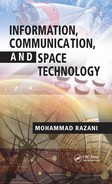5 Future Space Technologies
5.1 Introduction
Future space technologies could be viewed from those organizations that are in the forefront of space technologies. With no doubt, the National Aeronautics and Space Administration (NASA) would be on the top of such a list and their dreams and imagination for the years and perhaps decades ahead would give us a rather good understanding of where we are moving and what the goals and targets are in this area. Space technology has affected the lives of millions in different ways as we learned in this book so far, from numerous applications. The impact on education, on safety and security, on early warnings of natural disasters, on agriculture, on city planning, on navigation and tens, perhaps hundreds of other areas that our lives have been affected, are only examples of the applications of such technologies. We experience some of these applications on a day-to-day basis, and they have become part of our lives in such a way that we do not realize them. Some of the immediate impacts are hidden in research activities in the space environment that gradually find their ways into different disciplines. Although one might think that curiosity was perhaps the primary incentive for humans to search space and beyond, and of course no one denies that, at the same time we should realize that space-related activities are now taking a different shape and direction. Maybe economy is part of the reason that we no longer can afford to go to space just for the sake of going to space and partly because the conquest of the space in the last millennium has been sufficient to satisfy our ego and desire of wanting to go to space. Now we are at a different time when we go to space for a reason that is not only economically justifiable, but we can see its immediate impact on our lives whether the impact is on education, on the environment, on peace and security, on agriculture, or on the advancement of science and technology which paves the way for a better future for generations to come.
5.2 Space Technologies
NASA’s wish list for the future of space technology is being written by a NASA specialist as follows, which defines a Roadmap for Space Technology in different areas in the coming years1:
“NASA’s integrated technology roadmap, which includes both ‘pull’ and ‘push’ technology strategies, considers a wide range of pathways to advance the nation’s current capabilities in space. Fourteen draft Space Technology Area Roadmaps comprise the overall integrated map.”
NASA developed the set of draft roadmaps for use by the National Research Council (NRC) as an initial point of departure for mapping NASA’s future investments in technology. Through an open process of community engagement, the NRC will gather input, integrate, and prioritize each Space Technology Area Roadmap, providing NASA with strategic guidance and recommendations that inform the technology investment decisions of NASA’s space technology activities. Because it is difficult to predict the wide range of future advances possible in these areas, NASA plans to update the integrated technology roadmap on a regular basis. The 14 Roadmaps are as follows1:
TA01 Launch Propulsion Systems
TA02 In-Space Propulsion Technologies
TA03 Space Power and Energy Storage
TA04 Robotics, Tele-Robotics and Autonomous Systems
TA05 Communication and Navigation
TA06 Human Health, Life Support, and Habitation Systems
TA07 Human Exploration Destination Systems
TA08 Science Instruments, Observatories, and Sensor Systems
TA09 Entry, Descent, and Landing Systems
TA10 Nanotechnology
TA11 Modeling, Simulation, Information Technology, and Processing
TA12 Materials, Structures, Mechanical Systems, and Manufacturing
TA13 Ground and Launch Systems Processing
TA14 Thermal Management Systems
Figure 5.1 shows the communication and navigation roadmap. Figure 5.2 shows the roadmap for the Science Instruments, Observatories and Sensor Systems.
For each technology area, NASA established an internal team of subject matter experts who could reach out to other experts throughout NASA as needed. In some cases, the teams reached out to governmental agency experts, and to industry experts through fact-finding meetings. Figure 5.3a–e show that each team created a technology area breakdown structure.
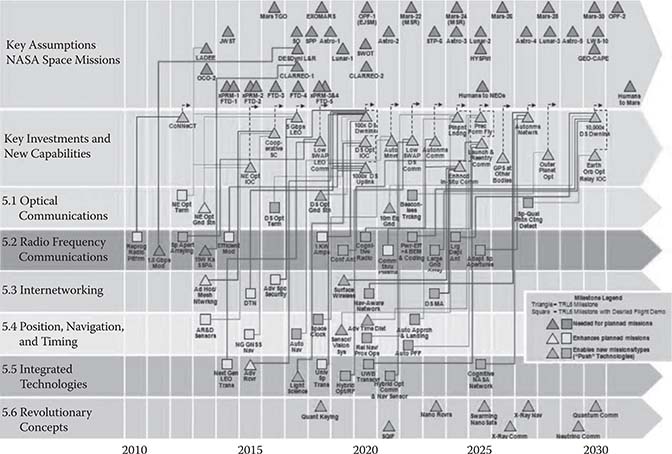
Figure 5.1 Technology Area 05: Communication and Navigation Systems Technology Area Strategic Roadmap. (TASR.)
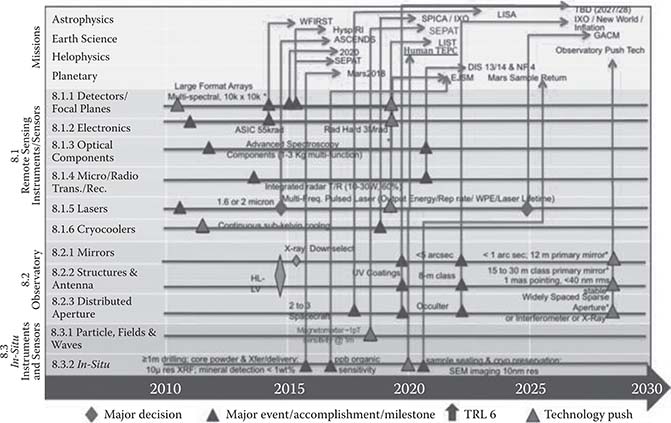
Figure 5.2 Technology Area 08: SIOSS #8 Technology Area Strategic Roadmap. (NASA: Science Instruments, Observatories and Sensor Systems.)
Each of these teams would then do the following:
Identify the top technical challenges that, if met, would achieve needed performance.
Identify the mission “pull” technologies needed to support the increased capabilities demanded by future planned NASA missions.
Identify emerging “push” technologies that could meet NASA’s long-term strategic challenges.
5.3 Nonrocket Space Launch
Rocket-based space launch is very expensive. Numbers such as $10,000 per kilogram is a normal cost for a rocket-based space launch. Table 5.1 shows the heavy lift launch vehicles worldwide.2 The super-heavy launch vehicles are shown in Table 5.2.
Nonrocket launchers are being introduced in space-related activities which will by some estimates revolutionize the space industry. These nonrocket launchers include the cable accelerator, circle launcher and space keeper, skyhooks, space elevator transport system, space towers, kinetic towers, the gas-tube method, sling rotary method, asteroid employment, electromagnetic accelerator, endo-atmospheric tethers, Sun and magnetic sails, solar wind sail, radioisotope sail, electrostatic space sail, laser beam, Slingatron, kinetic anti-gravitator (repulsitor), Earth-Moon or Earth-Mars nonrocket transport system, multireflective beam propulsion system, electrostatic levitation, and so forth.
To get a feeling for how different in cost the rocket-based versus non-rocket-based launch vehicles is, see Table 5.3 in which these two technologies are compared.
Figures 5.4 through 5.6 show three of these nonrocket-based vehicles.
5.4 Single Stage-to-Orbit
By definition a single-stage-to-orbit (SSTO) vehicle reaches orbit from the surface of a body without jettisoning hardware, expending only propellants and fluids. The term often refers to reusable vehicles. Although no Earth-launched SSTO launch vehicles have ever been constructed, it is an interesting technology that has attracted a lot of attention recently. Several research spacecraft have been designed or constructed, including Skylon, the DC-X, the X-33, and the Roton SSTO. One major obstacle in the successful launch to orbit by SSTO is problems with finding the most efficient propulsion system. SSTO has been achieved from the Moon by the Apollo program’s lunar module and several robotic spacecraft of the Soviet Luna program. Having less gravity and almost no atmosphere makes this much easier than from Earth. Figure 5.7 shows the VentureStar which was a proposed SSTO spaceplane, and Figure 5.8 shows VentureStar compared with the space shuttle.
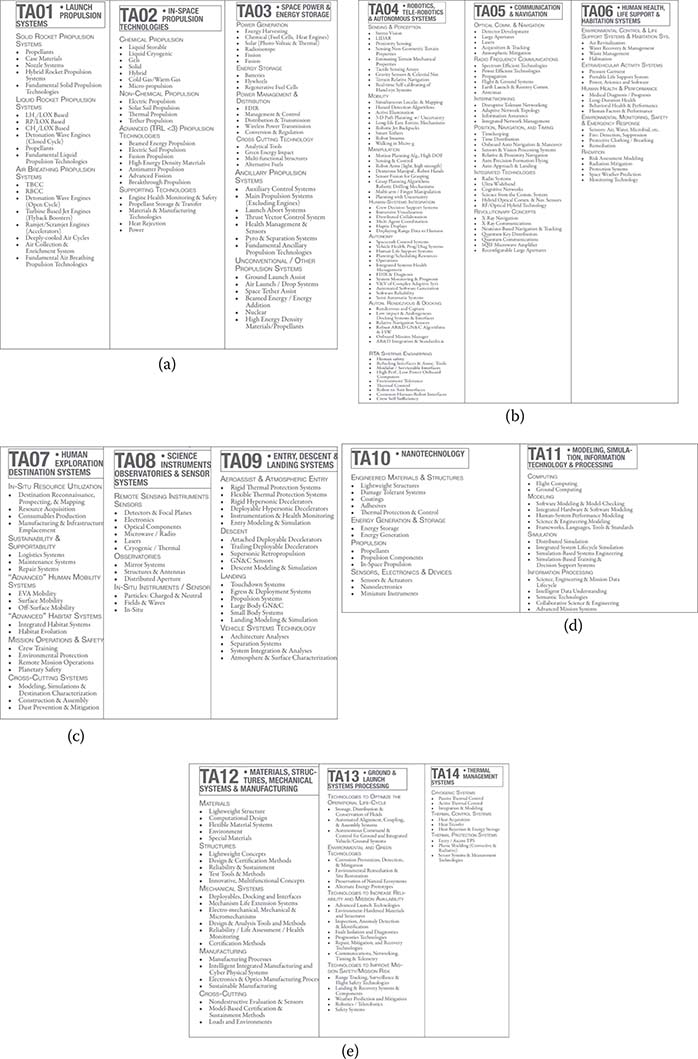
Figure 5.3 (a)–(e) Technology area breakdown structure.
Table 5.1 Heavy Lift Launch Vehicles
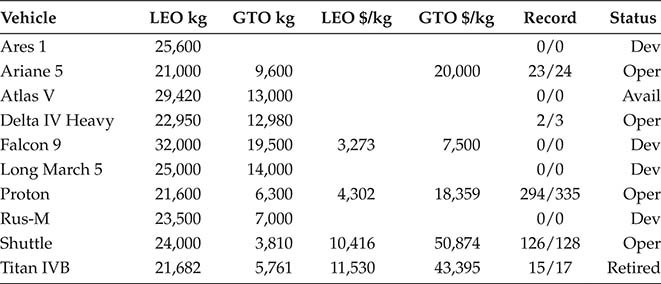
Table 5.2 Super-Heavy Launch Vehicles
Vehicle |
LEO kg |
TLI kg |
Record |
Status |
Ares V |
160,000 |
63,000 |
0/0 |
Can Pending |
Energia |
100,000/20,000(GTO) |
32,000 |
Retired |
|
N1 |
75,000 |
0/4 |
Canceled |
|
Saturn V |
118,000 |
47,000 |
11/12 |
Retired |
Saturn INT-21 |
75,000 |
1/1 |
Retired |
Table 5.3 Comparison between Rocket-Based and Nonrocket-Based Launching Vehicles
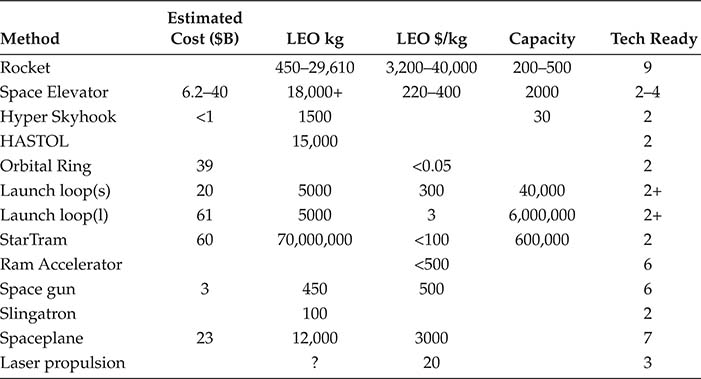
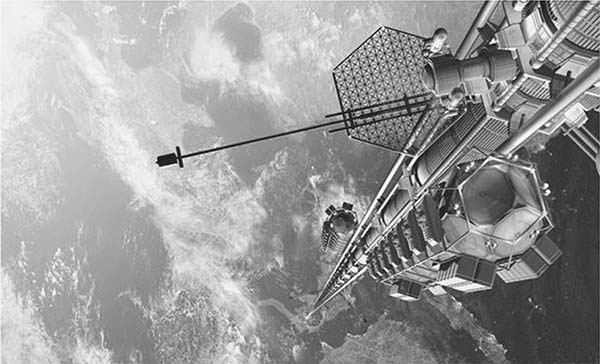
Figure 5.4 Space elevator.
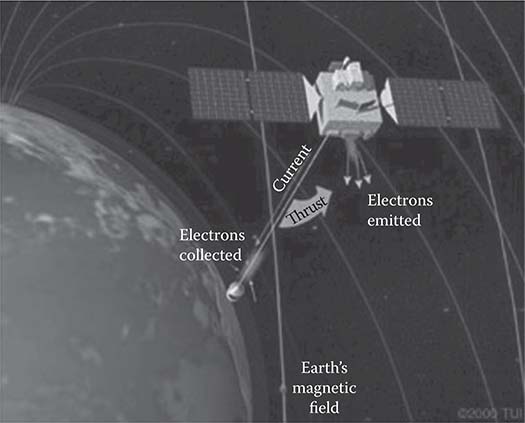
Figure 5.5 Electrodynamic tether.
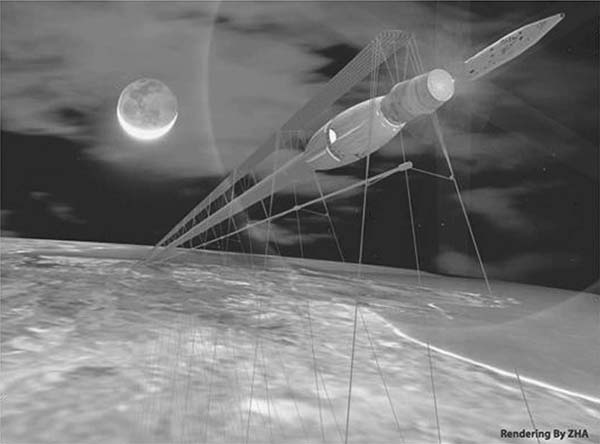
Figure 5.6 StarTram.
Cost savings (1/10 that of space shuttle) and increased safety makes the VentureStar’s engineering and design more attractive than the space shuttle. An airliner-like operation is the ultimate goal for an SSTO vehicle. The development of high-performance hydrogen-oxygen propulsion, pioneered by the General Dynamics Centaur, has encouraged the possibility of SSTO and has made this 40-year-old dream closer to reality.
Table 5.4 summarizes the main SSTO system requirements.3
Some unique characteristics of SSTO are as follows:
The SSTO will take off straight up, fly to orbit without dropping anything off, and will then land on its tail on a pillar of fire, not gliding but under power.
SSTOs will not require strap-on external tanks or boosters.
SSTOs will not need a long runway, a huge vehicle assembly building, or a mission control building. It will need only a 200-foot diameter concrete pad, a maintenance hanger, and a hydrogen/oxygen propellant facility.
SSTOs will navigate using satellite signals from the existing Global Positioning System.
Once fully operational a reusable SSTO will be as safe as flying on a typical commercial airliner.
Unlike the space shuttle, SSTOs will burn only hydrogen and oxygen. Their exhaust will consist primarily of hot but pure water vapor.
An anticipated turn-around will be about 1 day.

Figure 5.7 Proposed VentureStar.
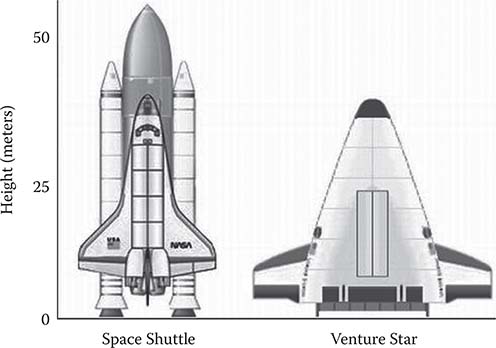
Figure 5.8 VentureStar compared with space shuttle.
Table 5.4 Key Single-Stage-to-Orbit (SSTO) System Requirements
|
Intact abort any time during flight (save the payload and/or crew) Rapid, low-cost turnaround (low operating costs using only 350 man-days) Medium payloads deployed and/or retrieved (10,000 lb to low Earth orbit) Manned and/or unmanned operation (automated flight plus inherent reliability and safety for crews) Rocket propulsion as the prime mover (avoid dependency on NASP air breathing technology) |
5.5 Solar Power Satellites
A solar power satellite (SPS) beams down energy to a reception area on Earth in the form of microwaves. The SPS system requires a global undertaking by all stakeholders from private to public enterprises.
Retired president of India, Dr. Kalam Abdul, spoke publicly on the prospects for space solar power while addressing a symposium on “The Future of Space Exploration” organized by Boston University. Referring to the population growth worldwide in the next 40 years (Figure 5.9), Abdul said, “What better vision can there be for the future of space exploration than participating in a global mission for perennial supply of renewable energy from space?”
Abdul believes that interdisciplinary research on space will enable new innovations in science and engineering. In his address at Boston University he also said, “Civilization will run out of fossil fuels in this century. Solar energy is clean and inexhaustible. However, solar flux on earth is available for just 6 to 8 hours every day whereas incident radiation on a space solar power station would be 24 hours every day.”
The Japanese developed in the System Definition Studies of the late 1970s and conducted some limited testing and proposed a low orbit 10 megawatt demonstration satellite. As one can imagine, the overwhelming initial cost of development and deployment of such a system has remained the primary obstacle. For solar power satellites to become economically feasible, there is need for a low-cost space transport, and for SPS to be successful, there is a need for an organized industry and a viable approach for SPS implementation.
SPSs are to be placed in low Earth orbit from which they will transmit the collected solar energy back to Earth by microwave transmission. Such a huge global undertaking needs the cooperation of different nations and an organization that could manage and monitor it worldwide. International involvement of UN member countries who are also members of ITU is mandatory for coordinating global treaties and agreements, frequency assignments, satellite orbital locations, space traffic control, and other activities to prevent any potential radio interference into their domestic communication systems and services. To make this global project possible, an international organization such as the International Telecommunications Union (ITU) is needed in which member countries elect the officials of the organization observing equitable geographical presentations and also based on a rotational system in which every member country in every region could participate in decision-making policies that would ultimately impact their nation. A very careful blend of the private sector should also be considered in the design of the system and the delivery of the service without any power in the decision-making processes. The various elements of the project involving government and industry partnerships must be clearly defined. The design, manufacturing, launching, operating, and maintaining such a global system of SPSs in space orbit would with no doubt involve sophisticated engineering technologies and require great human effort and ingenuity to meet all the challenges that are involved in such a project. It has been shown through recent history that if countries put their minds together, nothing that is imaginable and practical from engineering point of view would be impossible to achieve. This project is no exception to this rule. The distribution of solar energy worldwide using a space-based platform such as the one described here would provide an alternative source of energy to any point on Earth and would impact the global economy.
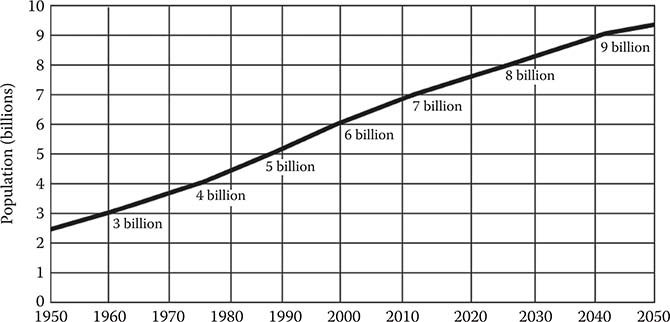
Figure 5.9 World Population: 1950-2050. (U.S. Census Bureau, International Data Base, 2008 First Update.)
As we can see from Figure 5.10, the SPS concept is more than 40 years old, and it has to be considered a viable source of energy by several countries before it can become a reality.
Figure 5.11 illustrates the different components of a possible SPS project.

Figure 5.10 Solar power satellite (SPS) overall design concept. (Billion Year Plan, http://billionyearplan.blogspot.com/2010/08/how-far-weve-come-space-based-solar.html.5)
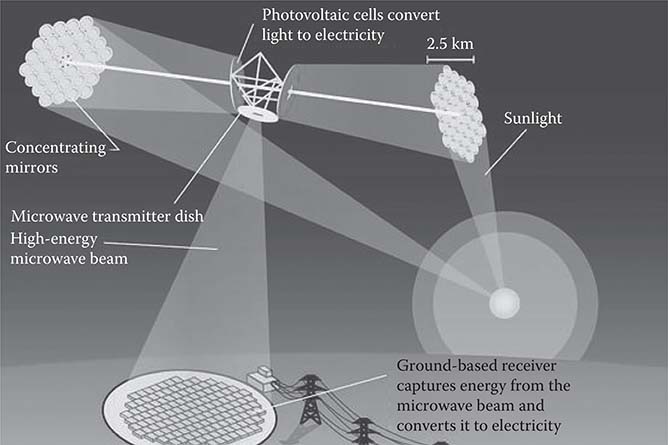
Figure 5.11 History of the solar power satellite (SPS) concept.
References
1. NASA space technology roadmaps available for public review and comment, 2011, http://www.spaceref.com/news/viewsr.rss.spacewire.html?pid=35863.
2. Non-rocket space launch, http://www.thefulfillment.org/docs/NonRocketSL. ppt.
3. Heald, D.A., and T.L. Kessler. Single stage to orbit vertical takeoff and landing concept technology challenges engineering manager, Advanced Space Concepts SSTO Chief Engineer General Dynamics Space Systems Division, San Diego, California, www.spacefuture.com/archive/single_stage_to_orbit_vertical_takeoff_and_landing_concept_technology_challenges.shtml.
4. Koomanoff, F.A., and C.E. Bloomquist. 1993. Solar POWER satellites. New York: Ellis Horwood, p. 26.
5. Billion Year Plan, http://billionyearplan.blogspot.com/2010/08/how-farweve-come-space-based-solar.html.
